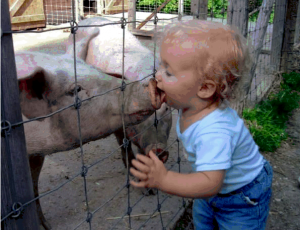Can’t blame the hog industry for being up in arms about labeling the new virus “swine flu.” The Obama administration, determined to rev up the economy, responded to hog farmers’ concerns by switching to the more neutral, H1N1 label, with which scientists have tagged the new strain.
A semantic adjustment, however, can only go so far to reassure the public that H1N1 cannot be caught from being in the vicinity of hog farms, or consuming meat and other products derived from pigs. Even as that message continues to be published and broadcast by the media, pork sales and prices keep dropping.

Should you be among those who pass up the pork chops, be aware that your shopping cart may still contain foods made from, or with pig products. For example, some of the gelatin in Jell-O, marshmallows and the aspic that gives some gourmet fare its kick comes from swine, as do the bacon bits in salads; ham slivers in split-pea soup and jambalaya; and even the casings of organic chicken and turkey sausages are pig intestines.
To avoid all pork products, read food labels carefully. Kosher foods are also kept strictly free of pork.
Considering that no one really knows whether the virus could be transmitted by handling or eating pork, we think it’s prudent and sensible to avoid it—especially since many of the poor animals already carry either the MRSA (methicillin-resistant staphylococcus aureus) bacteria, or its latest and deadlier ST398 strain (described in our recently posted “Pork—The Other (MRSA-tainted) White Meat” web log).
Scientists describe H1N1 as a “sloppy,” “unpredictable” and “unstable” organism, quite new and different from previous swine flu and other viruses, since it also contains avian and human DNA. No one has a clue when and how this organism will mutate or what danger it will pose to populations around the world. Therefore, governments and public health organizations such as the Center for Disease Control, for example, are wise to err on the side of caution. Even if that means annoying entire populations by keeping them on high alert with constant news updates of new cases and deaths. Forewarned is forearmed.
Ultimately, the decision of how much attention and preventive measures we are willing to invest in our own health and safety is up to each one of us.

